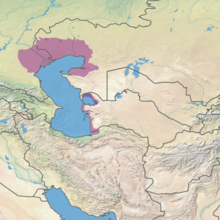Volga–Ural interfluve
The Volga–Ural interfluve (Kazakh: Еділ-Жайық өзені, Russian: Волго-Уральское междуречье) is a steppe, semidesert, and desert territory between rivers Volga and Ural in Kazakhstan and Russia.
In the vicinity of Volga Delta there are groups of Baer knolls [ru][a] with heights up to 25 m. Between them freshwater bayous and saltwater lakes may be formed.
Within the confines of Atyrau Region, Kazakhstan, bordering the Astrakhan Oblast, Russia, there is a huge sand massif formerly known as "Urdinskiye peski" (Урдинские пески)[b], now "Ryn-peski", or Ryn Desert.
In the 13th and 14th centuries the sedentary population was extremely sparse, with stationary settlements located along the valleys of Volga and Ural, as well as in the water-rich northern part of the interfluve.
The book discusses the following archaeological sites:[1] In more recent times the situation improved and a large number of kurgans, in particular, attributed to the Yamnaya culture, which, in particular, changed the notions about the significance of the development of metallurgy in the area in early Bronze Age.


